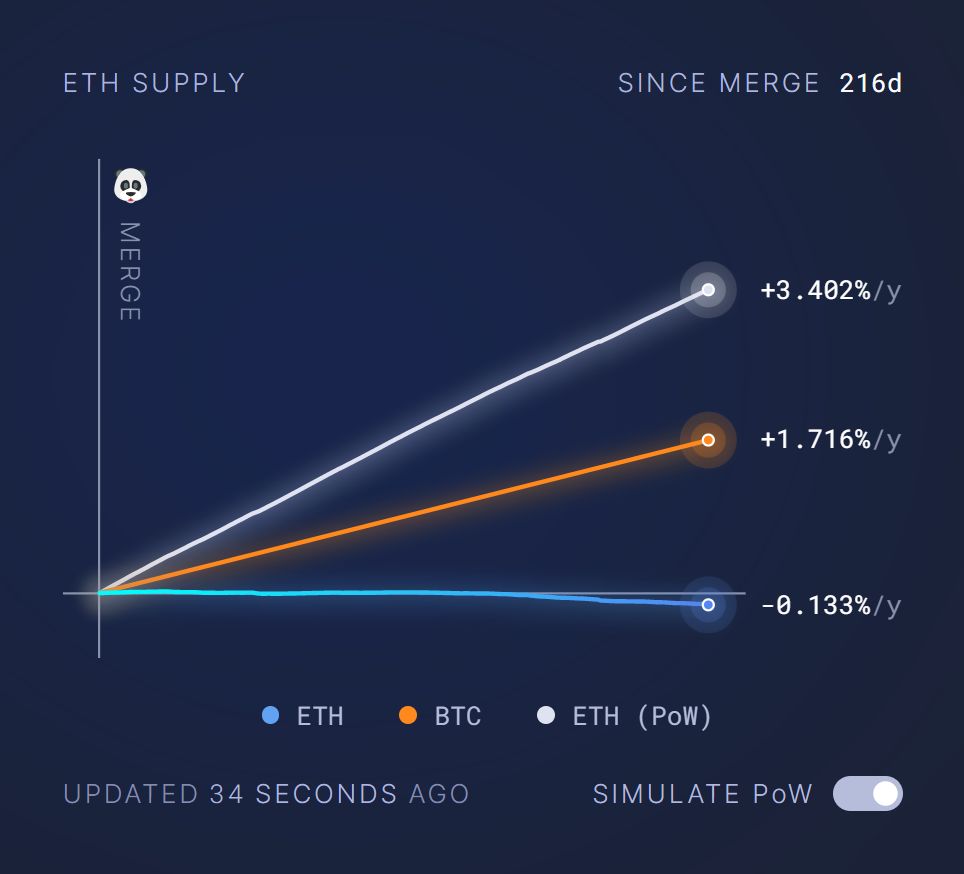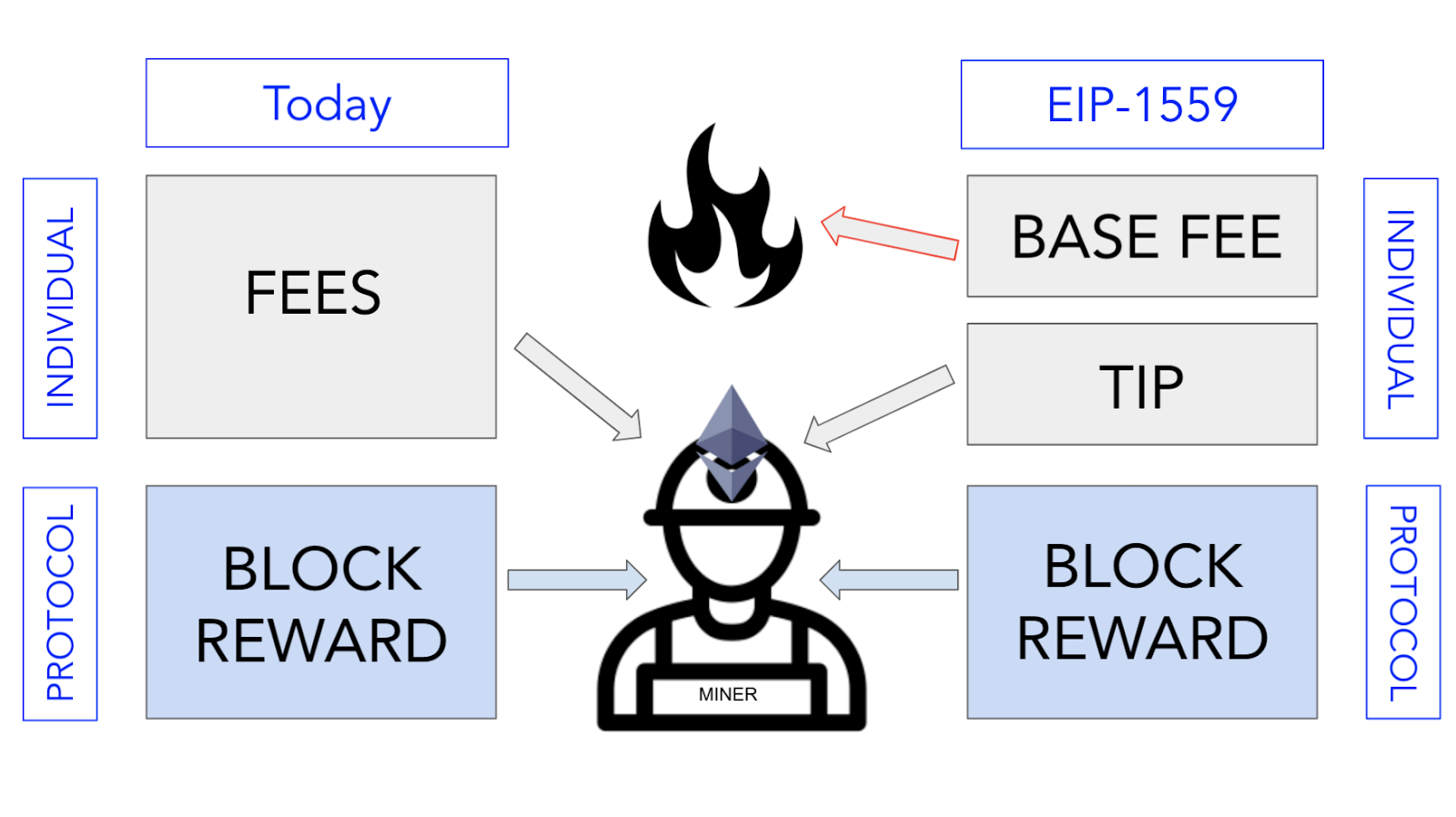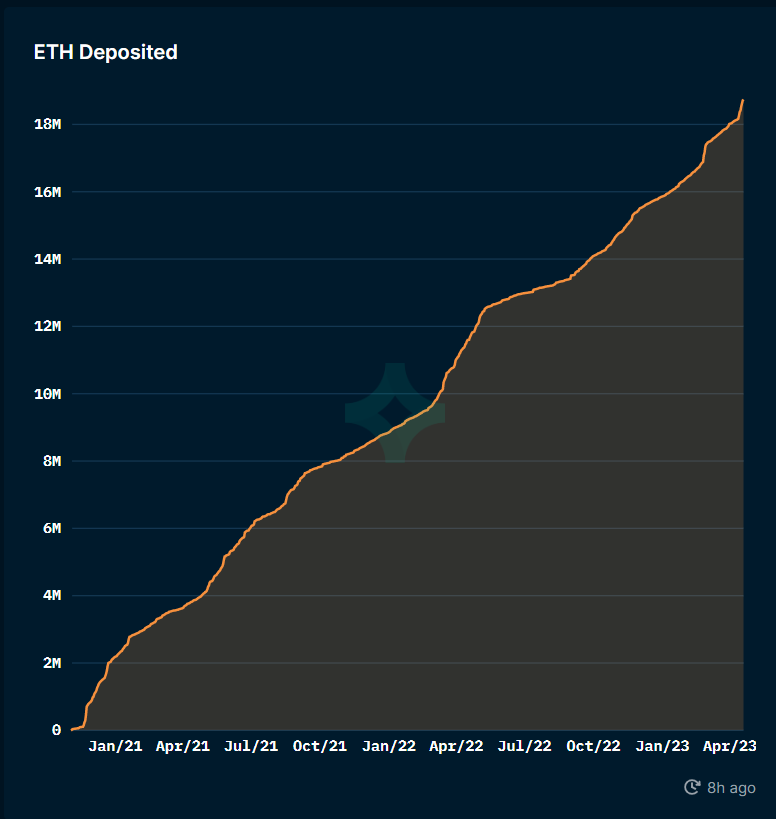What is Ethereum Triple Halving? How ETH Became Deflationary

If you’ve been around crypto for a while, you’ve probably heard of the Bitcoin halving, which is a highly anticipated event that happens every four years. But did you know about the Ethereum triple halving?
In this article, we’ll explain the Ethereum triple halving and how it can effect the prospects of ETH as a long-term investment.
Before we continue, we should make it clear that the name “Ethereum triple halving” is a bit deceiving—we’ll explain why in the next section of the article. Regardless, the name has been adopted by the crypto community, and the concept it describes is very important if you’re considering investing in ETH.
What is the Ethereum triple halving?
“Ethereum triple halving” is a term used to describe three factors that are providing deflationary pressure to the ETH supply. The term is inspired by the Bitcoin halving, which is a mechanism implemented in the Bitcoin protocol that cuts the issuance of new BTC coins by half roughly every four years.
However, it’s important to keep in mind that unlike the Bitcoin halving, the Ethereum triple halving is not an actual event built into the Ethereum protocol. Instead, it’s a term that the Ethereum community came up with to describe how new mechanisms implemented in the Ethereum protocol are helping reduce the supply of ETH.
The concept of the Ethereum triple halving consists of three main parts:
- Reduced ETH issuance under Proof-of-Stake consensus
- ETH burning via the EIP-1559 upgrade
- Ethereum staking lowers the amount of ETH that is effectively in circulation
Now, let’s explore how each of these factors is impacting the ETH supply and how they could help Ethereum recover from the crypto bear market.
The migration to Proof-of-Stake has led to reduced ETH issuance
Ethereum’s migration from Proof-of-Work to Proof-of-Stake has had a very significant impact on the ETH supply. The reason for this is quite simple—the Ethereum blockchain has to issue much fewer ETH to reward stakers than the amount of ETH it had to issue to reward miners.
Cryptocurrency mining is an energy-intensive process that requires a significant upfront investment in mining hardware. Meanwhile, staking requires much less energy and is cheaper to get started with. Therefore, the network needs to issue a smaller amount of ETH to reward stakers adequately compared to the amount of ETH it had to issue to incentivize miners.
More specifically, the Ethereum protocol was issuing around 13,000 ETH per day to reward miners under the Proof-of-Work model. Under the new Proof-of-Stake model, the Ethereum protocol only has to issue about 1,600 ETH per day to reward stakers. This is a reduction of about 87.7%.
According to ETH supply tracker ultrasound.money, the Ethereum supply has decreased by 91,860 ETH from September 15, 2022 to April 18, 2023 (the time of writing). According to the aggregator’s estimates, the supply would have instead increased by 2.41 million ETH in the same time period if Ethereum still used Proof-of-Work.
In the following chart, you can see how the supply of ETH has changed since the transition to Proof-of-Stake (September 15, 2022). For comparison, the chart also includes the change in Bitcoin’s supply and the change in ETH supply if it still used Proof-of-Work (simulated).

As we can see, ETH has been slightly deflationary since the transition over to the Proof-of-Stake consensus mechanism. If this trend continues, it favors long-term ETH holders since ETH will become increasingly scarce, providing positive pressure to the coin’s price.
However, there’s no guarantee that the ETH supply will continue to be deflationary forever, as we’ll explain in the following section.
EIP-1559 and transaction fee burning
So, we learned that the ETH issuance rate has dropped to about 1,600 ETH per day since the Merge. But if 1,600 new ETH is being created every day, how has the supply of ETH decreased?
The answer lies in the EIP-1559 upgrade, which was activated through the London hard fork in August 2021. The upgrade reworked Ethereum’s transaction fee structure with a mechanism in which the base ETH gas fee paid for transactions is burned. It also gave Ethereum users the option to add a “tip” for validators to have their transaction prioritized.

Comparing the Ethereum transaction fee mechanisms before and after EIP-1559. Image source: ConsenSys
EIP-1559 is the reason why the ETH supply has decreased despite new ETH coins being created every day to reward validators. The amount of ETH that’s being burned of course depends on how much ETH users are paying for transactions on the Ethereum network. So, when demand for transactions on Ethereum grows, more ETH is burned.
So far, the amount of ETH burned through EIP-1559 has outpaced the amount of ETH that’s being issued, resulting in a slight reduction in the ETH supply. If demand for transactions for Ethereum drops in the future, however, we could see ETH becoming inflationary again.
ETH staking
ETH staking is the third factor included in the Ethereum triple halving concept. Following the move to Proof-of-Stake, ETH holders can stake their coins to help secure the Ethereum network and earn staking rewards in exchange.
Essentially, staking Ethereum provides another incentive to passively hold ETH and lock it up in staking, which temporarily removes it from circulation (staked coins cannot be sold without being unstaked first).
This part of the Ethereum triple halving has become a bit less relevant recently. This is because the Shapella upgrade, which was enabled on April 12, 2023, introduced the ability to withdraw staked ETH coins. Between the introduction of Ethereum staking in December 2020 and the Shanghai upgrade, staked ETH could not be withdrawn, so they were truly removed from circulation.
Now that ETH holders have the option of withdrawing their staked coins, staked ETH can no longer be counted as removed from circulation. Still, the ability to stake ETH is an incentive against selling, so one could still argue that ETH staking is a positive influence on ETH as a long-term investment.
At the time of writing, Nansen data shows there’s about 18.7 million staked ETH, which represents 15.6% of the ETH supply.

Interestingly enough, the number of staked ETH took a sharp uptick following the Shapella upgrade, which is an indication that the ability to unstake ETH has given investors more confidence to stake their coins.
When is the Ethereum triple halving happening?
Unlike the Bitcoin halving, the Ethereum triple halving is not an actual event, so it doesn’t have a date. All the mechanisms described by the term Ethereum triple halving have already been implemented, so we can say that the Ethereum triple halving has already happened and will continue to be in effect so long as the Ethereum protocol is changed in a relevant way.
The ETH triple halving has already turned the ETH supply deflationary, although there’s no guarantee that it will remain this way. Due to the burn mechanics introduced in EIP-1559, the fluctuations in the ETH supply are determined by the demand for transactions on the Ethereum network. If ETH continues to be deflationary, the Ethereum triple halving could positively impact the long-term Ethereum price prediction.
The bottom line — The Ethereum triple halving has made ETH a better long-term investment
The Ethereum triple halving’s impact on the ETH supply has made ETH a more attractive asset to hold over the long term, as it significantly reduced the amount of new ETH coins that are entering circulation. In fact, ETH has even turned slightly deflationary after the last part of the Ethereum triple halving, the transition to Proof-of-Stake, was implemented in September 2022.
Of course, the Ethereum triple halving is only one of the factors to consider when evaluating Ethereum as an investment. It’s also important to keep up with developments on the Ethereum scalability front, which will ultimately determine whether Ethereum will be able to gain truly widespread adoption.






 Bitcoin
Bitcoin  Ethereum
Ethereum  Tether
Tether  USDC
USDC  TRON
TRON  Dogecoin
Dogecoin  Cardano
Cardano  Bitcoin Cash
Bitcoin Cash  Chainlink
Chainlink  LEO Token
LEO Token  Stellar
Stellar  Monero
Monero  Litecoin
Litecoin  Hedera
Hedera  Zcash
Zcash  Dai
Dai  Cronos
Cronos  OKB
OKB  Tether Gold
Tether Gold  Ethereum Classic
Ethereum Classic  KuCoin
KuCoin  Gate
Gate  Algorand
Algorand  VeChain
VeChain  Cosmos Hub
Cosmos Hub  Dash
Dash  Stacks
Stacks  Tezos
Tezos  TrueUSD
TrueUSD  IOTA
IOTA  Basic Attention
Basic Attention  Decred
Decred  Theta Network
Theta Network  NEO
NEO  Synthetix
Synthetix  Qtum
Qtum  Ravencoin
Ravencoin  0x Protocol
0x Protocol  DigiByte
DigiByte  Zilliqa
Zilliqa  Nano
Nano  Siacoin
Siacoin  Numeraire
Numeraire  Waves
Waves  Ontology
Ontology  Enjin Coin
Enjin Coin  Status
Status  Pax Dollar
Pax Dollar  BUSD
BUSD  Hive
Hive  Lisk
Lisk  Steem
Steem  Huobi
Huobi  NEM
NEM  OMG Network
OMG Network  Augur
Augur  Bitcoin Gold
Bitcoin Gold  Ren
Ren  HUSD
HUSD